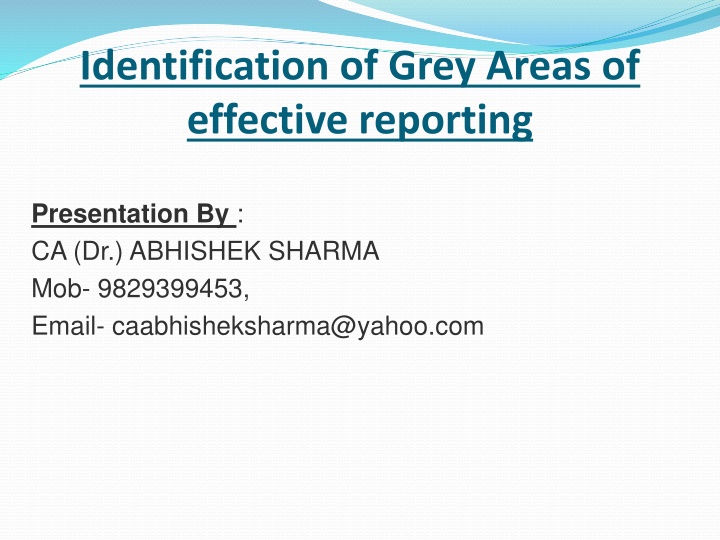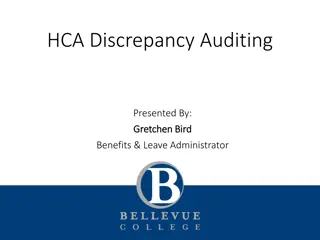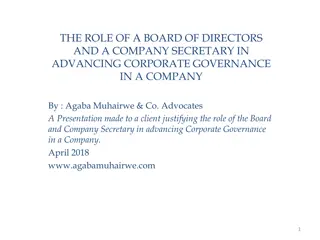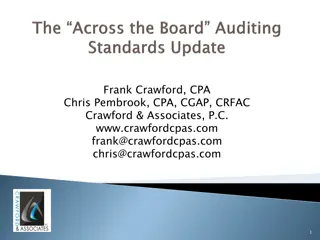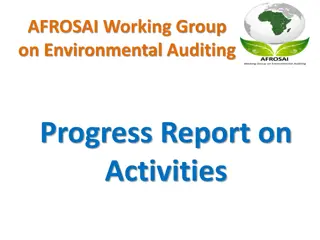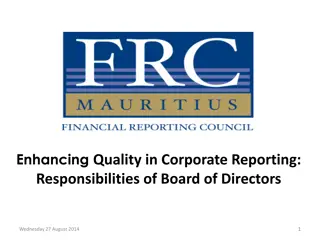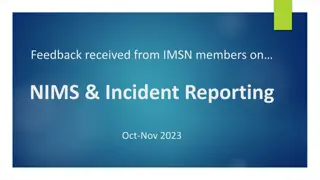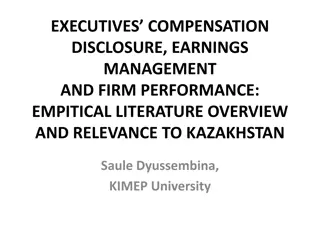Key Aspects of Effective Reporting in Auditing & Corporate Governance
Effective reporting in auditing involves identifying grey areas, exercising due professional care, detecting material misstatements, and ensuring corporate governance. Auditors must be vigilant, apply their skills diligently, and provide reasonable assurance to stakeholders. Corporate governance plays a crucial role in directing and controlling companies towards long-term success and prudent management.
Download Presentation

Please find below an Image/Link to download the presentation.
The content on the website is provided AS IS for your information and personal use only. It may not be sold, licensed, or shared on other websites without obtaining consent from the author.If you encounter any issues during the download, it is possible that the publisher has removed the file from their server.
You are allowed to download the files provided on this website for personal or commercial use, subject to the condition that they are used lawfully. All files are the property of their respective owners.
The content on the website is provided AS IS for your information and personal use only. It may not be sold, licensed, or shared on other websites without obtaining consent from the author.
E N D
Presentation Transcript
Identification of Grey Areas of effective reporting Presentation By : CA (Dr.) ABHISHEK SHARMA Mob- 9829399453, Email- caabhisheksharma@yahoo.com
Grey Areas of audit reporting More precautions should be done while auditing and submission of report. If anything found suspicious then reporting should be done accordingly. Due Professional care Material misstatement Corporate governance Reasonable assurance Red flags-key indicators of potential fraud Gross negligence
Due Professional Care Auditors must apply the care and skills expected of a reasonably prudent and competent auditor. Due professional care does not imply infallibility. Due professional care is exercised when audits are carried out in accordance with the standards set for the profession. The exercise of due professional care allows the auditor to obtain reasonable assurance about whether the financial statements are free of material misstatement, whether caused by error or fraud, or whether any material weaknesses exist as of the date of management's assessment.
Material Misstatement A material misstatement is information in the financial statements that is sufficiently incorrect that it may impact the economic decisions of someone relying on those statements, i.e. users of the Financial Statements. The risk of material misstatement is the risk that the financial statements of an organization have been misstated to a material degree. For example, a material misstatement of revenue could trigger a decision to buy a company's stock, causing losses for the investor when the misstatement is later corrected and the price of the stock declines.
Corporate Governance Corporate governance is the system by which companies are directed and controlled. Boards of directors are responsible for the governance of their companies. The shareholders role in governance is to appoint the directors and the auditors and to satisfy themselves that an appropriate governance structure is in place. The purpose of corporate governance is to facilitate effective, entrepreneurial and prudent management that can deliver the long-term success of the company. ICICI Bank V/s Videocon Group
Reasonable Assurance Reasonable assurance is a high level of assurance regarding material misstatements, but not an absolute one. Reasonable assurance includes the understanding that there is a remote likelihood that material misstatements will not be prevented or detected on a timely basis. To achieve reasonable assurance, the auditor needs to obtain sufficient appropriate audit evidence to reduce audit risk to an acceptably low level. This means that there is some uncertainty arising from the use of sampling, since it is possible that a material misstatement will be missed.
Red flags-key indicators of potential fraud Fraud red flags refer to undesirable situations or conditions that consistently contribute to fraud, waste, and abuse of resources. When an investigator is reviewing a company s stocks or financial statements, certain undesirable characteristics may stand out as fraud red flags. These are some of the examples of Red Flags:- Inventory shrinkage Missing documents Multiple payments Spikes in invoice volume Excessive number of adjusting entries
Gross Negligence Gross negligence is a severe form of negligence. Its severity has been characterized using the presence of a mental element or mens rea accompanying the negligent act. Within the context of professional negligence, gross negligence is important as it constitutes professional misconduct. Negligence vs Gross Negligence:- Difference is a matter of degree. Negligence is failure to exercise due care. Gross negligence is a reckless departure from the standard of due care. Gross Negligence v. Fraud:- Fraud is different from gross negligence in that there is an intent to deceive.
Gross Negligence- illustration Balance Sheet of XYZ Ltd As on 31st March 2022 (In Rs Lakhs) Liabilities Amount Assets Amount Share Capital 200Fixed Assets 450 Secured Loans 350Cash & Bank Balance 120 unsecured loans 225Sundry receivables 170 sundry creditors 58Stock 150 other current liabilities 42Other current Assets 35 Total 925Total 925
Common mistakes or carelessness- Auditor found that there was very small Closing balance at the year end which represents the transactions between 02 related/unrelated companies , but maximum amount outstanding during the year is very high. Auditors should be more cautious and if found suspicious reporting should be done.- FMP/ALP Interest on borrowed fund should be capitalized as per AS 16, but it is shown as revenue expenditure to decrease the profit. 02 companies are said to be independent (may be holding or subsidiary) No role in decision making .but if you gone through the board meeting, business of other company is getting discussed.
Common mistakes or carelessness- Valuation of stock- on FIFO/weighted average method, but in many case it is done on simple average method. Verification of opening balances as per books of accounts/as per balance sheet. Fixation of priority. Working papers. Physical visit or physical verification of stock. Failure to exercise due professional care. Casual approach. Revaluation of assets or valuer report etc.
Common mistakes or carelessness- Covid-19 impact reporting, for example hotel industry, tour and travel industry etc. Non-compliances observed in regard to the Ind-AS s, Companies Act, 2013, or any other governing law as applicable. Proper Disclosure of the items which may influence the decision of the users of the Financial Statements. Proper valuation of the cost of the Finished Goods Inventory with incorporating all the adjustments whether ordinary or extra-ordinary.
Common mistakes or carelessness- Proper disclosure of all the items that are required to be disclosed in CARO Report as per the requirement of the Companies Act, 2013. Disclosure of the previous year s depreciation if there is change in the estimate or method of depreciation, it should be separately shown in the financials. The nature and purposes of the various provisions, contingent liabilities and assets should also be disclosed. Proper disclosure of the nature and classifications of the Investments whether long and short term investments.
Common mistakes or carelessness- Abnormal movement in revenue figures/profit % Continuously outstanding trade receivables and advance recoverable (sometimes even more than sales figure), trade receivable belongs to related companies Abnormal changes in expenses Ratio Analysis Segment analysis Change in the head of ledger of balance sheet (ex. Nature of advance)
Common mistakes or carelessness- Frequent changes in auditors- A big red flag ? Random Verification of customers/suppliers- Whether we do ? Violation of compliances of various laws- Have we checked ever ?
Cases of Audit Failure Yes Bank Ltd, IL&FS, Satyam computers, Vakrangee Ltd, Manpasand beverages Ltd these are some of the audit failure cases in the last decade.
Common mistakes or carelessness- Issues related to bank audit Diversion of funds- funds given to one company diverted to another group company. Interest head- may be personal loan is getting charged with home loan interest Fraud- diversion of fund i.e. taking overdraft in account, payment transferred in an account having ID of advance manager of bank. Joint account with his wife, LIC agent etc.
Common mistakes or carelessness- Issues related to bank audit Wrong use of export credit limits- M/s ABC Ltd. have been sanctioned Packing credit limit of Rs. 10.00 crores from bank. Unit is doing export as well as domestic sales. All the payments have been routed through current A/c after PC is transferred to Current A/c. It means that export credit limits are getting utilized for purposes other than export also as payment for suppliers against procurement for domestic sales are also made from this Current A/c.
o Correlation between export orders & Actual sales- PC is getting availed from bank on the basis of exports order received and also disbursed to Current A/c according to orders. Once pc is disbursed it is transferred to current account and its end use is not monitored. In some cases, bank does not verify these exports orders against which disbursement is made with the actual sales but many of these orders do not get convert in actual sales. Transactions with the sister concern: Many times it is find out that the purchase & sales transactions are getting done through sister concern only, by not disclosing the fact to the banks. Over pricing of invoice issues are common in these transactions. This may cause in banks fund are getting out of business in purchase transaction and having a threat of infusing the hawala money from abroad in sale transactions.
Loan from other banks- Sometimes it is found that the borrower is also availing credit limits from other banks and neither the same is informed to the existing lender bank, nor the separate bifurcation details of the same is mentioned in the balance sheet. Review/renewal of account- Need to examine review/ renewal application and sanction to verify that it is not mere entry in bank server to avoid NPA and penal interest. Double financing of the same stock- Through separate limit for various entities of group concern from same bank or different bank.
Willful defaulters- need to check thoroughly. Includes person having capacity to repay the loan but are not paying. Verification could be done with the sister concern accounts or accounts of same person with other bank or other accounts in same bank. Verification of the sales figure- GST returns, E-way bill, Transport bilty along with toll tax receipts. Physical verification of some borrowers- such verification should be done on random basis along with the bank branch staff to verify the existence and working of the borrower. False mention of stock statement receipt date in system- the same is entered in the system on regular basis even though non receiving the same, just to avoid the penal interest and NPA.
Investigative /Forensic Audit Investigative Auditing consists of the prevention, detection and quantification of fraud, money laundering, terror finance and corruption. Investigative Auditing involves the examination of accounts and the use of accounting procedures to discover financial irregularities and to follow the movement of funds and assets in and out of organizations. The objects of Investigative Auditing include, inter alia: Identification of suspects; Determination of damages; Quantification of damages; Prevention of damage; Identification of financial activity; Tracing of financial assets. Investigation time ?--- days/months/years
Investigation/Forensic audit Robert Maxwell s Embezzlement,Europe-14 years Husband wife dispute- property valuation Sir. Paul McCartney and Heather Mills Divorce National Spot Exchange Ltd Scam- 5600 crore
